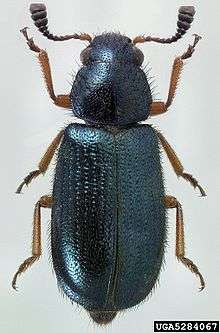Necrobia rufipes
| Necrobia rufipes | |
|---|---|
 | |
| Scientific classification | |
| Kingdom: | Animalia |
| Phylum: | Arthropoda |
| Class: | Insecta |
| Order: | Coleoptera |
| Family: | Cleridae |
| Genus: | Necrobia |
| Species: | N. rufipes |
| Binomial name | |
| Necrobia rufipes (Fabricius, 1781) | |
The red-legged ham beetle, Necrobia rufipes is a predatory beetle in the family Cleridae with a cosmopolitan distribution.[1]
The adult beetles are 3.5–7.0 millimetres (0.1–0.3 in) long, convex, straight sided, and the surface has indentations called punctures. They are shiny metallic green or greenish blue in colour. The legs and antennae are red (dark clubs). They feed on the meat-infesting larvae of Calliphora or blow flies, Dermestidae and Piophilidae. The adults are surface feeders; the larvae bore into dry or smoked meats and do most damage. The red-legged ham beetle also attacks bones, hides, copra, dried egg, cheese, guano, bone meal, dried figs, and palm nut kernels. Although refrigeration has reduced the impact of the beetle on meats they are the most significant pest of dried and salt fish including herring. They have been recorded in Egyptian mummies and were once known as Necrobia mumiarum Hope, 1834. Related species are Necrobia violacea which has all-dark legs and antennae and Necrobia ruficollis has light-coloured bases of the elytra(shoulders). It is not to be confused with Korynetes caeruleus also the steely blue beetle in the family Cleridae. Both beetles have a significance in forensic entomology but for different reasons.
References
- ↑ C. P. Haines & D. P. Rees (1989). "Necrobia rufipes". A field guide to the types of insects and mites infesting cured fish. Food and Agriculture Organization. ISBN 92-5-102827-3.